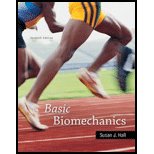
Concept explainers
The radius of gyration of the thigh with respect to the transverse axis at the hip is 54% of the segment length. The mass of the thigh is 10.5% of total body mass, and the length of the thigh is 23.2% of total body height. What is the moment of inertia of the thigh with respect to the hip for males of the following body masses and heights?
| MASS (kg) | HEIGHT (m) | |
| A | 60 | 1.6 |
| B | 60 | 1.8 |
| C | 70 | 1.6 |
| D | 70 | 1.8 |
(Answers: A = 0.25 kg m2; B = 0.32 kg m2; C = 0.30 kg m2; D = 0.37 kg m2)
To determine: The moment of inertia of the thigh with respect to the hip for males A, B, C, and D.
Answer to Problem 1AP
The moment of inertia of the thigh with respect to the hip for males A, B, C, and D are
Explanation of Solution
Calculation:
Expression for the moment of inertia is,
Here,
The radius gyration is certain percentage of length of the thigh and length of the thigh is certain percentage of total body height.
The moment of inertia of male A:
Rewrite equation (1).
Substitute
Thus, the moment of inertia of male A is
The moment of inertia of male B:
Rewrite equation (1).
Substitute
Thus, the moment of inertia of male B is
The moment of inertia of male C:
Rewrite equation (1).
Substitute
Thus, the moment of inertia of male C is
The moment of inertia of male D:
Rewrite equation (1).
Substitute
Thus, the moment of inertia of male B is
Therefore, the moment of inertia of the thigh with respect to the hip for males A, B, C, and D are
Want to see more full solutions like this?
Chapter 14 Solutions
Basic Biomechanics
- Watch this video (http://openstaxcollege.org/l/flexext) to learn more about the flexion and extension of the knee, as the femur both rolls and glides on the tibia to maintain stable contact between the bones in all knee positions. The patella glides along a groove on the anterior side of the distal femur. The collateral ligaments on the sides of the knee become tight in the fully extended position to help stabilize the knee. The posterior cruciate ligament supports the knee when flexed and the anterior cruciate ligament becomes tight when the knee comes into full extension to resist hyperextension. What are the ligaments that support the knee joint?arrow_forwardWhich statement is tine concerning the knee joint? The lateral meniscus is an intrinsic ligament located on the lateral side of the knee joint. Hyperextension is resisted by the posterior cruciate ligament. The anterior cruciate ligament supports the knee when it is flexed and weight bearing. The medial meniscus is attached to the tibial collateral ligament.arrow_forwardThe talus bone of the foot receives the weight of the body from the tibia. The talus bone then distributes this weight toward the ground in two directions: one-half of the body weight is passed in a posterior direction and one-half of the weight is passed in an anterior direction. Describe the arrangement of the tarsal and metatarsal bones that are involved in both the posterior and anterior distribution of body weight.arrow_forward
- Lifetime Physical Fitness & WellnessHealth & NutritionISBN:9781337677509Author:HOEGERPublisher:Cengage
 Anatomy & PhysiologyBiologyISBN:9781938168130Author:Kelly A. Young, James A. Wise, Peter DeSaix, Dean H. Kruse, Brandon Poe, Eddie Johnson, Jody E. Johnson, Oksana Korol, J. Gordon Betts, Mark WomblePublisher:OpenStax College
Anatomy & PhysiologyBiologyISBN:9781938168130Author:Kelly A. Young, James A. Wise, Peter DeSaix, Dean H. Kruse, Brandon Poe, Eddie Johnson, Jody E. Johnson, Oksana Korol, J. Gordon Betts, Mark WomblePublisher:OpenStax College





